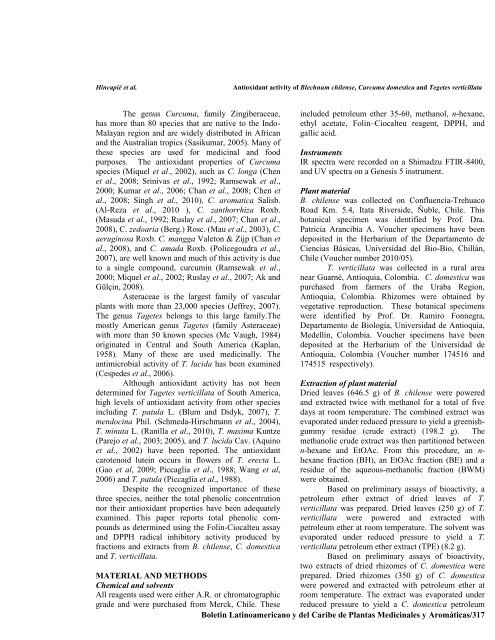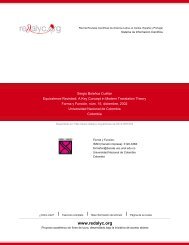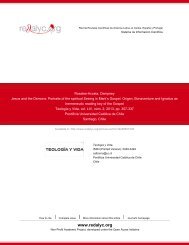(Kaulf.) Mett., Curcuma domestica Valeton and Tagetes ... - Redalyc
(Kaulf.) Mett., Curcuma domestica Valeton and Tagetes ... - Redalyc
(Kaulf.) Mett., Curcuma domestica Valeton and Tagetes ... - Redalyc
You also want an ePaper? Increase the reach of your titles
YUMPU automatically turns print PDFs into web optimized ePapers that Google loves.
Hincapié et al. Antioxidant activity of Blechnum chilense, <strong>Curcuma</strong> <strong>domestica</strong> <strong>and</strong> Tegetes verticillata<br />
The genus <strong>Curcuma</strong>, family Zingiberaceae,<br />
has more than 80 species that are native to the Indo-<br />
Malayan region <strong>and</strong> are widely distributed in African<br />
<strong>and</strong> the Australian tropics (Sasikumar, 2005). Many of<br />
these species are used for medicinal <strong>and</strong> food<br />
purposes. The antioxidant properties of <strong>Curcuma</strong><br />
species (Miquel et al., 2002), such as C. longa (Chen<br />
et al., 2008; Srinivas et al., 1992; Ramsewak et al.,<br />
2000; Kumar et al., 2006; Chan et al., 2008; Chen et<br />
al., 2008; Singh et al., 2010), C. aromatica Salisb.<br />
(Al-Reza et al., 2010 ), C. zanthorrhiza Roxb.<br />
(Masuda et al., 1992; Ruslay et al., 2007; Chan et al.,<br />
2008), C. zedoaria (Berg.) Rosc. (Mau et al., 2003), C.<br />
aeruginosa Roxb. C. mangga <strong>Valeton</strong> & Zijp (Chan et<br />
al., 2008), <strong>and</strong> C. amada Roxb. (Policegoudra et al.,<br />
2007), are well known <strong>and</strong> much of this activity is due<br />
to a single compound, curcumin (Ramsewak et al.,<br />
2000; Miquel et al., 2002; Ruslay et al., 2007; Ak <strong>and</strong><br />
Gülçin, 2008).<br />
Asteraceae is the largest family of vascular<br />
plants with more than 23,000 species (Jeffrey, 2007).<br />
The genus <strong>Tagetes</strong> belongs to this large family.The<br />
mostly American genus <strong>Tagetes</strong> (family Asteraceae)<br />
with more than 50 known species (Mc Vaugh, 1984)<br />
originated in Central <strong>and</strong> South America (Kaplan,<br />
1958). Many of these are used medicinally. The<br />
antimicrobial activity of T. lucida has been examined<br />
(Cespedes et al., 2006).<br />
Although antioxidant activity has not been<br />
determined for <strong>Tagetes</strong> verticillata of South America,<br />
high levels of antioxidant activity from other species<br />
including T. patula L. (Blum <strong>and</strong> Didyk, 2007), T.<br />
mendocina Phil. (Schmeda-Hirschmann et al., 2004),<br />
T. minuta L. (Ranilla et al., 2010), T. maxima Kuntze<br />
(Parejo et al., 2003; 2005), <strong>and</strong> T. lucida Cav. (Aquino<br />
et al., 2002) have been reported. The antioxidant<br />
carotenoid lutein occurs in flowers of T. erecta L.<br />
(Gao et al, 2009; Piccaglia et al., 1988; Wang et al,<br />
2006) <strong>and</strong> T. patula (Piccaglia et al., 1988).<br />
Despite the recognized importance of these<br />
three species, neither the total phenolic concentration<br />
nor their antioxidant properties have been adequately<br />
examined. This paper reports total phenolic compounds<br />
as determined using the Folin-Ciocalteu assay<br />
<strong>and</strong> DPPH radical inhibitory activity produced by<br />
fractions <strong>and</strong> extracts from B. chilense, C. <strong>domestica</strong><br />
<strong>and</strong> T. verticillata.<br />
included petroleum ether 35-60, methanol, n-hexane,<br />
ethyl acetate, Folin–Ciocalteu reagent, DPPH, <strong>and</strong><br />
gallic acid.<br />
Instruments<br />
IR spectra were recorded on a Shimadzu FTIR-8400,<br />
<strong>and</strong> UV spectra on a Genesis 5 instrument.<br />
Plant material<br />
B. chilense was collected on Confluencia-Trehuaco<br />
Road Km. 5.4, Itata Riverside, Ñuble, Chile. This<br />
botanical specimen was identified by Prof. Dra.<br />
Patricia Arancibia A. Voucher specimens have been<br />
deposited in the Herbarium of the Departamento de<br />
Ciencias Básicas, Universidad del Bio-Bio, Chillán,<br />
Chile (Voucher number 2010/05).<br />
T. verticillata was collected in a rural area<br />
near Guarné, Antioquia, Colombia. C. <strong>domestica</strong> was<br />
purchased from farmers of the Uraba Region,<br />
Antioquia, Colombia. Rhizomes were obtained by<br />
vegetative reproduction. These botanical specimens<br />
were identified by Prof. Dr. Ramiro Fonnegra,<br />
Departamento de Biología, Universidad de Antioquia,<br />
Medellín, Colombia. Voucher specimens have been<br />
deposited at the Herbarium of the Universidad de<br />
Antioquia, Colombia (Voucher number 174516 <strong>and</strong><br />
174515 respectively).<br />
Extraction of plant material<br />
Dried leaves (646.5 g) of B. chilense were powered<br />
<strong>and</strong> extracted twice with methanol for a total of five<br />
days at room temperature. The combined extract was<br />
evaporated under reduced pressure to yield a greenishgummy<br />
residue (crude extract) (198.2 g). The<br />
methanolic crude extract was then partitioned between<br />
n-hexane <strong>and</strong> EtOAc. From this procedure, an nhexane<br />
fraction (BH), an EtOAc fraction (BE) <strong>and</strong> a<br />
residue of the aqueous-methanolic fraction (BWM)<br />
were obtained.<br />
Based on preliminary assays of bioactivity, a<br />
petroleum ether extract of dried leaves of T.<br />
verticillata was prepared. Dried leaves (250 g) of T.<br />
verticillata were powered <strong>and</strong> extracted with<br />
MATERIAL AND METHODS<br />
petroleum ether at room temperature. The solvent was<br />
evaporated under reduced pressure to yield a T.<br />
verticillata petroleum ether extract (TPE) (8.2 g).<br />
Based on preliminary assays of bioactivity,<br />
two extracts of dried rhizomes of C. <strong>domestica</strong> were<br />
prepared. Dried rhizomes (350 g) of C. <strong>domestica</strong><br />
Chemical <strong>and</strong> solvents<br />
were powered <strong>and</strong> extracted with petroleum ether at<br />
All reagents used were either A.R. or chromatographic room temperature. The extract was evaporated under<br />
grade <strong>and</strong> were purchased from Merck, Chile. These reduced pressure to yield a C. <strong>domestica</strong> petroleum<br />
Boletin Latinoamericano y del Caribe de Plantas Medicinales y Aromáticas/317

















